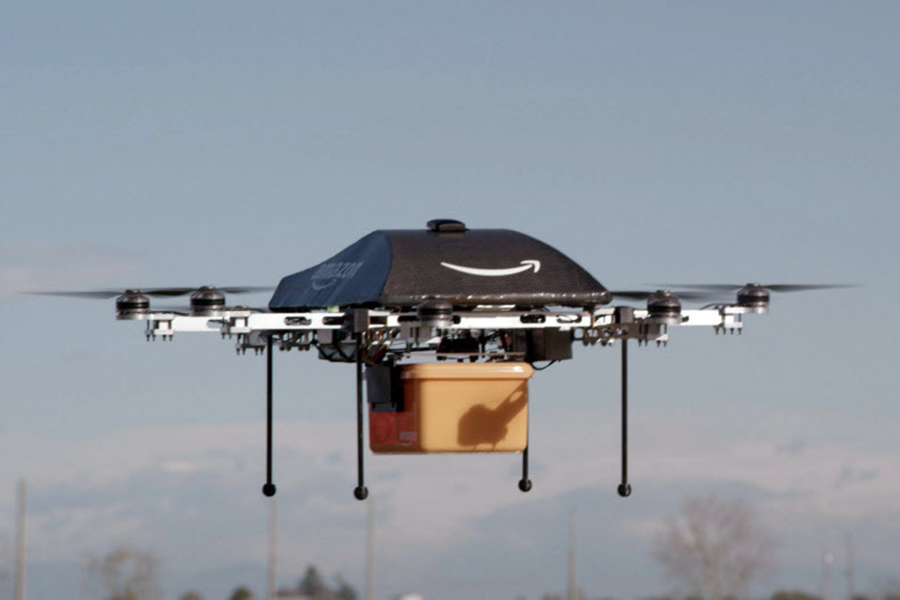Why Amazon is taking its experimental delivery drones to Britain
In a new partnership with the United Kingdom's Civil Aviation Authority (CAA), Amazon will now be testing new autonomous aerial technology that it hopes will one day function in its Amazon Prime Air drone delivery service.
Amazon will be conducting tests that extend beyond-line-of-sight of the operator, but still under 400 feet of airspace, throughout rural and suburban Great Britain. The purpose of this round of testing is to hone the "sense and avoid" technology and provide the safety statistics needed to put Amazon Prime Air in business. The Federal Aviation Administration (FAA), the United State's equivalent of the CAA, does not currently allow for this type of drone testing, although with increased use of drones in both commercial and federal levels, this may change in the future.
"The UK is a leader in enabling drone innovation – we've been investing in Prime Air research and development here for quite some time," Paul Misener, Amazon's vice president of global innovation policy and communications, said in an announcement. "This announcement strengthens our partnership with the UK and brings Amazon closer to our goal of using drones to safely deliver parcels in 30 minutes to customers in the UK and elsewhere around the world."
In Britain, Amazon will be testing devices that weigh less than 55 pounds, can operate up to 10 miles away from the line of sight of the operator, and are programed to overcome certain mechanical failures. When Amazon Prime Air comes to fruition, Amazon hopes it will enhance the Prime service it already provides to millions of its customers with quicker and more environmentally friendly delivery.
While the CAA will be overseeing all the drone testing, Britain has been particularly progressive about the development of drones, Liam Maxwell, Britain's national technology adviser, said at an Amazon event last month. He added that Amazon was one of many major companies testing drones in out of sight airspace in Britain.
Canada and the Netherlands are also hosting Amazon drone testing, according to a statement by Jeff Bezos, chief executive officer of Amazon.
The United States has historically been more conservative on the issue of drone use.
Earlier this summer the FAA released its new rules for commercial drone use, which are too narrow to allow for the kind of testing going on in Britain. In the US, operators are required to always be within the line of site of the drone, which prevents the kind of delivery testing Amazon has in mind. Additionally, drones cannot fly over people who are not participating in the operation itself.
Although these rules, which go into effect in August, are more strict than many had hoped for, reactions have still been positive.
"This is a watershed moment in how advanced technology can improve lives, as the Small UAS Rule allows companies, farmers, researchers and rescue services alike to explore how drones can let them do more at a lower cost and a lower risk," Brendan Schulman, vice president of policy and legal affairs for DJI, the world's largest drone company, told TechCrunch.
The technology has already shown its many potential uses and fostered innovation in the US.
In California, firefighters are looking to pair drones with the satellite aerial mapping they already rely on to fight the wildfires that are currently ravaging the West Coast. Drones are capable of descending very close to the fire and gathering data about the speed and heat of a fire, which will help firefighters form their plan of attack, without endangering human life.
Additionally, Amazon is not the only tech giant working on drones. Facebook's chief executive officer Mark Zuckerberg announced last week that the next step in his goal to get everyone in the world online involved solar powered drones in order to deliver the internet to far flung rural areas – and there has already been one successful test flight.
A spokesperson for Amazon told TechCrunch that Amazon is looking to establish a way to operate Amazon Prime Air in the US as well, and is currently "working with regulators and policymakers in many countries in order to make Prime Air a reality for our customers and expect to continue to do so."





